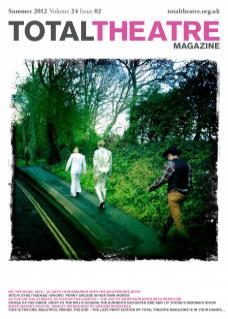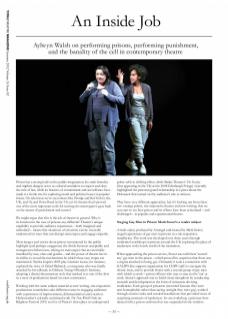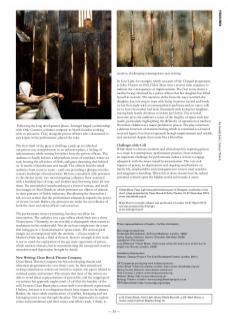Prison has a strong hold on the public imagination. Its stark brutality and implicit dangers serve as cultural reminders to respect and obey the rule of law, while its features of containment and surveillance have made it a fertile site for exploring moral and political issues in popular forms. On television we’ve seen shows like Porridge and Bad Girls in the UK, and Oz and Prison Break in the US, yet it’s theatre that’s proved one of the most important tools for turning the interrogative gaze back on the means of punishment and control.
We might argue that this is the job of theatre in general. Why is its function in the case of prisons any different? Theatre’s unique capability to provide audience experiences – both imagined and embodied – means that situations of extremity can be viscerally understood in ways that can disrupt stereotypes and engage empathy.
Most images and stories about prison encountered by the public highlight (and perhaps exaggerate) the divide between acceptable and transgressive behaviours, relying on stereotypes that are inevitably inscribed by race, class and gender – and the power of theatre lies in its ability to reveal the mechanisms by which these easy tropes are maintained. Tanika Gupta’s 2005 play Gladiator Games, for instance, explored the story of Zahid Mubarek, a young man who was fatally attacked by his cellmate in Feltham Young Offender’s Institute, adopting a drama-documentary style that marked it as one of the first in a wave of productions based on court testimonies.
Working with the same subject material as new writing, site-responsive productions nonetheless take different routes in engaging audiences with experiences of imprisonment, dehumanisation and coercion. Hydrocracker’s critically acclaimed work The New World Order (at Brighton Festival 2011) set five of Pinter’s short plays in underground police cells to chilling effect, while Badac Theatre’s The Factory (first appearing in the UK at the 2008 Edinburgh Fringe) viscerally highlighted the prisoner/guard relationship in a piece about the Holocaust that turned on the audience’s role as witness.
They have very different approaches, but it’s looking out from these two vantage points, site-responsive theatre and new writing, that we can start to see how prison and its effects have been articulated – and challenged – in popular and experimental theatre.
Staging Gay Men in Prison: Mark Storor’s a tender subject
A tender subject, produced by Artangel and created by Mark Storor, staged experiences of gay men in prisons in a site-responsive installation. The work was developed over three years through residential workshops in prisons around the UK exploring the place of tenderness in the harsh world of the institution.
When approaching the prison service, Storor was told there ‘weren’t any’ gay men in the prison – which proved his suspicion that there was a stigma attached to being gay. Ultimately it took a connection with GALIPS (the support organisation for LGBT staff) to navigate the thorny issue, and to provide Storor with a second group of gay men with which to work – prison officers who may or may not be ‘out’ at work. Storor’s approach was to build visual metaphors by conducting research and development in the form of miniature devising residencies. Each group of prisoners (recruited because they were anti-homophobic rather than saying outright they were gay), worked through creative tasks and curated installations that provided views of surprising moments of tenderness. In one workshop, a prisoner slow-danced with a prison uniform that was suspended in the window.
Following the long development phase, Artangel forged a relationship with Only Connect, a theatre company in North London working with ex-prisoners. They, alongside prison officers who volunteered to participate in the performance, played the roles.
The first third of the piece is thrilling: a pick up in a blacked-out prison van, transportation to an unknown place, a feeling of indeterminacy while waiting for orders from the prison officers. The audience is finally led into a labyrinthine series of corridors, where we wait, hearing far-off noises of flesh, and gates slamming shut behind us. It smells of disinfectant and mould. The officers lead the small audience from room to room – each one providing a glimpse into the sensory landscape of incarceration. We have encounters with prisoners in the shower room: two men navigating a slippery floor scattered with a hundred bars of soap, and another man throwing water all over them. I’m reminded of waterboarding as a form of torture, and recall those images of Abu Ghraib, in which prisoners are objects of ridicule in their postures of fleshly indecency. Recollecting the discomfort I felt, it’s not certain that the performance adequately unpacks the power of viewer/viewed. Rather, the prisoners are under the surveillance of both the stern and silent officers and ourselves.
The performance invites witnessing, but does not allow for intervention. The audience sees a gay officer climb back into a closet Trojan horse. Ultimately, we are not able to distinguish what counts as tenderness in this underworld. Nor do we have insight into the issues that being gay in a ‘homonormative’ space raises. The stereotypical images are counterpoised with the uncanny – a house made of Mother’s Pride bread, a field of flowers. Storor’s triumph in this work is not so much the exploration of the gay male experience of prison, which remains obscure, but in communicating the unexpected sensory stimulation and deprivation brought by denial.
New Writing: Clean Break Theatre Company
Clean Break Theatre Company has been developing theatre and education programmes for over thirty years. In their annual new writing commission, writers are invited to explore any aspect related to criminal justice and women. This means that most of the writers are able to avoid direct representations of prison life, and the trappings of voyeurism that approach might entail. (I call this the banality of the cell.) In most Clean Break plays, crime itself is not directly represented, I believe, because it is so ubiquitous that it loses impact in the theatre. Rather, the more subtle machinations of conflict, belonging and not belonging seem to run through the plays. The opportunity to explore crime and punishment and their causes and effects leads, I think, to creative, challenging contemporary new writing.
In Fatal Light, for example, which was part of the Charged programme at Soho Theatre in 2010, Chloë Moss uses a reverse time sequence to indicate the consequences of imprisonment. The first scene shows a mother being informed by a police officer that her daughter has killed herself in custody. The narrative shifts from the ways in which the daughter, Jay, is trying to cope with being in prison (scared and lonely on her first night with an unsympathetic pad-mate and no one to talk to) to how the mother had been threatened with losing her daughter, tracing back family divisions to before Jay’s birth. The reversed structure gives the audience a sense of the fragility of space and time inside, particularly highlighting the difficulty of separation of mothers from their children as a major problem in prison. The play constructs a delicate structure of maternal feeling which is examined as a kind of reversed legacy: loss that is repeated through imprisonment and suicide, and emotional despair that seems like a bloodline.
Challenges of the Cell
While there is obvious aesthetic and ethical merit in exploring prison as a trope in contemporary performance practice, there remains an important challenge for performance makers in how to engage adequately with the issues raised by incarceration. The very real impacts of prison, its deprivations and ongoing ramifications on family life, employability and reintegration in society need sensitive and imaginative handling. When this is done, theatre has the radical potential to break open the hidden world and remake it anew.
Main stage productions:
Timberlake Wertenbaker, Softcops (Barbican, London, 1984)
Tanika Gupta, Gladiator Games (Crucible, Sheffield, 2005)
Installation/ Promenade
Lucy Kirkwood / Clean Break, It felt empty when the heart went at first but its alright now (Arcola, London, 2009)
Installation/Intervention:
Rideout, Gotojail Project: The Cell (Southbank Centre, London, 2011)
UK Companies producing work in/about prisons:
Clean Break Theatre Company, London: http://www.cleanbreak.org.uk/
Dance United, National: www.dance-united.com
Only Connect, London: www.onlyconnectuk.org
Rideout, Stoke: http://www.rideout.org.uk/
Synergy Theatre, London: www.synergytheatreproject.co.uk
TIPP, Manchester: http://www.tipp.org.uk/tipp
Chloë Moss’ Fatal Light was performed as part of Charged, a collection of six short plays presented by Clean Break at Soho Theatre 10-27 November 2010. www.cleanbreak.org.uk
Mark Storor’s a tender subject was performed in London 16-31 March 2012 and was produced by Artangel. www.artangel.org.uk


